No upsets so far. Mr. Taco's Restaurant [review] turned in a fairly solid performance, and is certainly not on my shit list like Flash Taco and Lazo's. But it was really no match for De Pasada [review]. This is all starting to point toward a very interesting Ashland Regional final between De Pasada and La Pasadita.
8/23/07
De Pasada [#4] defeats Mr. Taco's Restaurant [#13]
Posted by
Nate Silver
at
6:39 PM
0
comments
![]()
De Pasada: Round 1 Review
#4. De Pasada
1108 N. Ashland
Tacos al Pastor
3 @ $1.65 each = $4.95 (no extras) You had me at tomatillo.
You had me at tomatillo.
The quality of the salsa is not an absolutely foolproof measure of a taqueria's ultimate quality, but it's a pretty damned powerful leading indicator. In just one bite, you can tell whether the salsa is made from fresh ingredients or has been sitting in a vat for several hours, and whether the chef has a good tongue or is just running through the motions. De Pasada's salsa, which I first experienced about a month ago, is absolutely wonderful -- the roja, yes, but especially the verde. It is an aggressive blend with plenty of character and texture, and you can see from the residue of seeds and tomatillos that De Pasada does not skimp on flavor. It's very much worth the walk down Ashland to try De Pasada, the quieter, younger sister of La Pasadita that sits almost literally in its shadow; even its sign is partially concealed by an overgrowth of trees.
The Food: De Pasada does have tacos al Pastor after all! A quick search of an online menu indicated that the closest substitute was probably barbacoa, but al Pastor is right on the chalkboard, as presumably it has always been.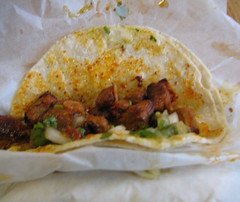 De Pasada's Pastor follows the same basic formula of Mr. Taco's, the pork accompanied by onion, cilantro, and a double tortilla (it did not feature a lime, as Mr. Taco's did). Each taco is wrapped in its own sheet of wax paper, which is not very photogenic (nor very green) but helps to keep the tacos nice and warm.
De Pasada's Pastor follows the same basic formula of Mr. Taco's, the pork accompanied by onion, cilantro, and a double tortilla (it did not feature a lime, as Mr. Taco's did). Each taco is wrapped in its own sheet of wax paper, which is not very photogenic (nor very green) but helps to keep the tacos nice and warm.
Since my central criticism of my last set of tacos was with the quality of its meat, the first thing I did was to gnaw on a chunk of the pork. The difference was recognizable immediately; this pork was nice and tender with subtle hints of smoke, and it was cut into attractive, even-sized pieces. You'd be happy to eat it on its own.
Really, though, that's not how you should be eating al Pastor. Rather, you should be folding the taco into a U-shape and taking a big, aggressive bite, because that way you'll get the spice of the pork to compliment the onions, cilantro, and salsa. My friend has a saying that the hallmark of a good meal is that every bite tastes a little different, and that was sort of the case here; some bites were more mild and others were more potent, depending on the onion-to-cilantro-to-salsa ratio. The spicing on the pork itself was good, though perhaps not quite as nuanced as Mr. Taco's, but taken as a coherent entity, these tacos were real winners.
The Experience: De Pasada has a cheerily-colored interior with perhaps six tables, which are spaced out comfortably rather than bunched together. The service was fast and friendly, and the waitress spoke very good English. The waitress had her 9-year-old son with her (she spoke English to him too), and it's evident that this place is family-run and takes a lot of pride in what it does; they're really deserving of your business.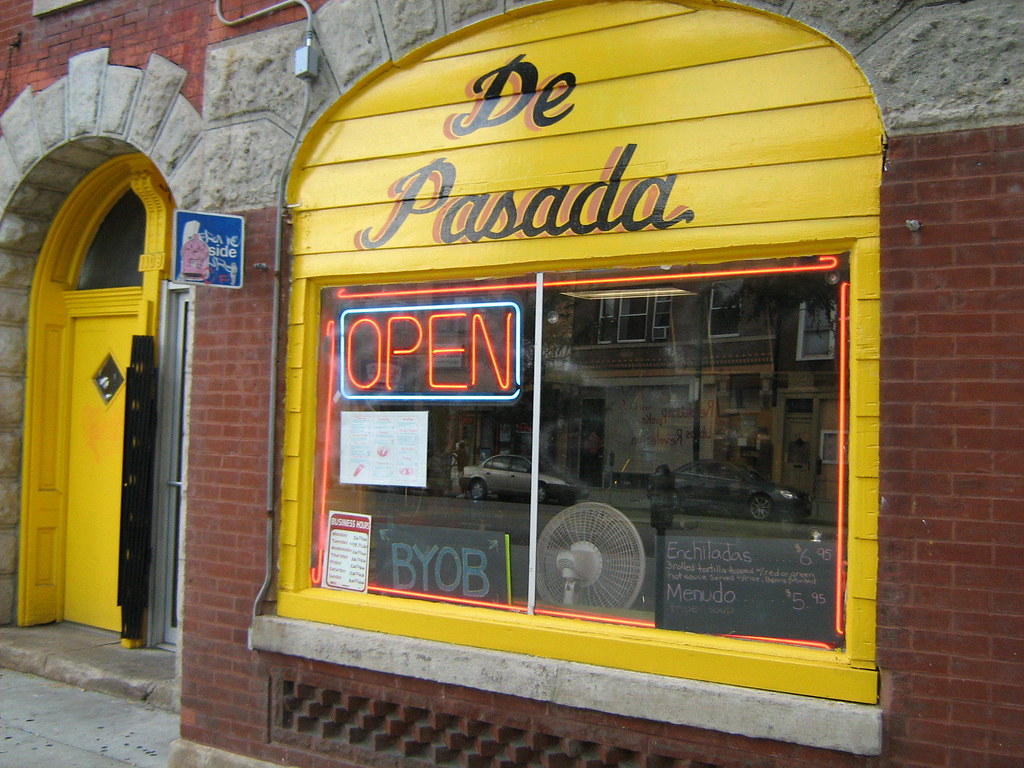
Posted by
Nate Silver
at
5:42 PM
2
comments
![]()
It's Raining Carnicerias
Shit. I was afraid that would happen.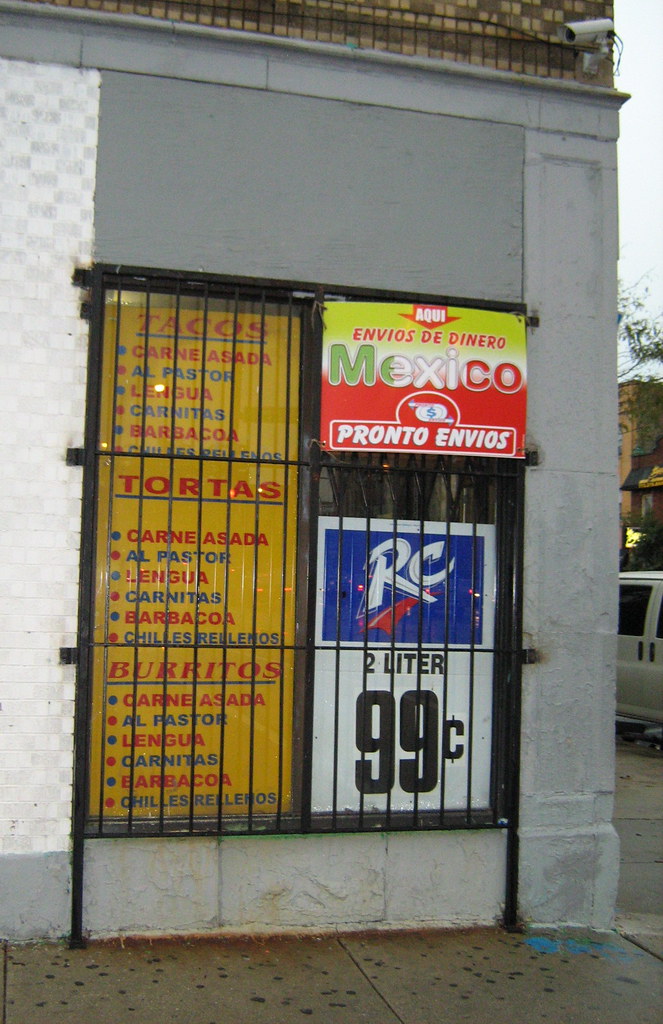 A helpful poster in the Mr. Taco's thread advised me that I ought to check out the al Pastor at Carniceria Leon, located at 1402 N. Ashland. I had no idea that this place existed, even though it's within a 90-second walk from my apartment. I'm sure that I'd passed it before, but perhaps I'd assumed that it was some kind of spin-off of Carniceria Guanajuato, the formidable Mexican supermarket just up the block.
A helpful poster in the Mr. Taco's thread advised me that I ought to check out the al Pastor at Carniceria Leon, located at 1402 N. Ashland. I had no idea that this place existed, even though it's within a 90-second walk from my apartment. I'm sure that I'd passed it before, but perhaps I'd assumed that it was some kind of spin-off of Carniceria Guanajuato, the formidable Mexican supermarket just up the block.
So I went out in the rain and ... well, Carnicera Leon is there. It isn't much to look at, but it's there, and it serves carnitas and al Pastor but not chicken, which makes it kind of bad-ass. So we have little choice but to include it in our bracket, where it will move into an "eat-in" match with Dona Naty's Taco for possession of the #12 seed.
Posted by
Nate Silver
at
4:42 PM
5
comments
![]()
8/21/07
Mr. Taco's Restaurant: Round 1 Review
#13. Mr. Taco's Restaurant
810 N. Marshfield
Tacos al Pastor
3 @ $1.60 each = $4.80 (no extras)
(Note: De Pasada is closed on Tuesdays, so we'll break convention and review the underdog first.)
Variations on "Mr. Taco" have to be among the most common names of Mexican restaurants in the United States, the equivalent of a Chinese restaurant calling itself "Peking Express" or an Indian restaurant "Ghandi". There used to be a "Mr. Taco" where I grew up in East Lansing, Michigan, a small chain which was sort of a ghettoized version of Taco Bell; its only customers were stoners and a few misguided vegans in search of bean burritos, and it closed several years ago. The Chicago version of "Mr. Taco" is noteworthy for the unique use of the possessive case in its name. It isn't "Mr. Tacos' Restaurant", which would seem to imply a restaurant owned by a dude who sold tacos, but rather "Mr. Taco's Restaurant", which would seem to imply a restaurant owned by a giant taco. Well, that's how I read it at least.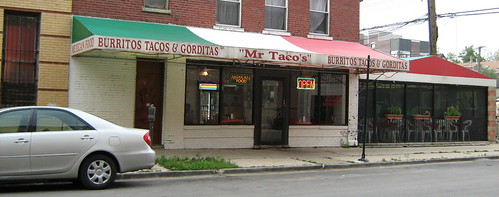
You probably wouldn't stumble across Mr. Taco's if you weren't meaning to; I first came upon it rather on accident when my friend was looking for a Currency Exchange to renew his parking stickers. Although just steps away from the busy Chicago/Ashland intersection, it's tucked out of view on residential Marshfield Ave., and its dreary storefront doesn't do much to pique one's curiosity. Nevertheless, it has some reasonably good food to offer.
The Food: Because of the careful preparation they require, tacos al Pastor are not particuarly easy to find on Chicago menus. (Mr. Taco's round 1 opponent, the relatively authentic De Pasada, does not in fact offer them, and so we will have to make the rather liberal substitution of tacos de barbacoa.) As such, this was one of my first experiences with al Pastor, but I think I'm a convert: it has more potential to wow the palate than other "mystery meat" variants like barbacoa and chorizo.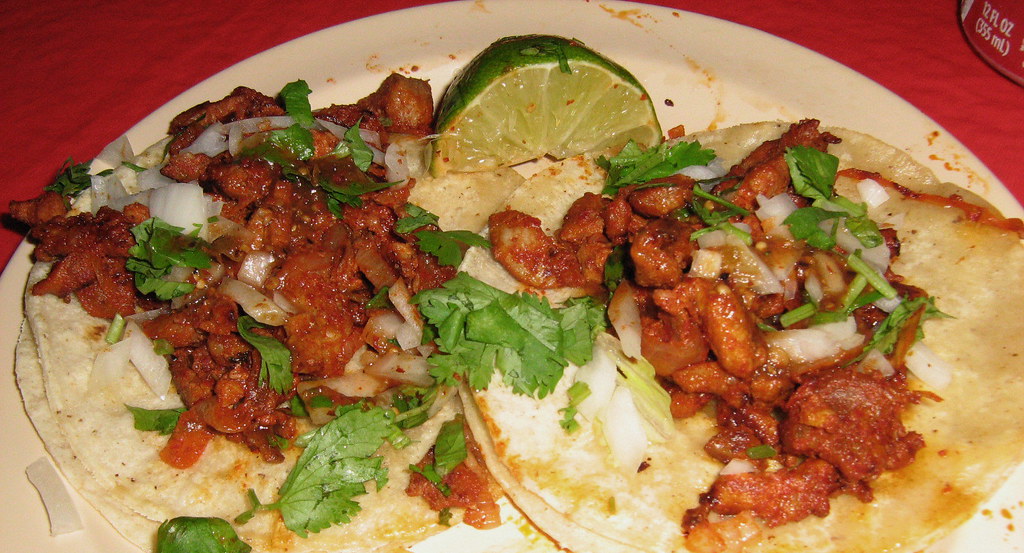
Mr. Taco's version of al Pastor is rich with flavor and visually attractive (not quite done justice to in the picture you see above). Accompanied by fresh onion, cilantro, a wedge of lime, and two deliciously soft tortillas, the sliced pork is a vibrant hue of orange, making for a dramatic accompaniment to the red tablecloth (and a dramatic contrast to pretty much everything else in the restaurant). The flavor itself might also be described as vibrant, especially when accompanied by the relatively potent squeeze-bottle salsa. There are several different flavors going on here, but the best analogy is probably to a good enchilada sauce, with hints of roasted spices and chilis.
The problem -- and it's a major one -- is that the spice is making up for meat of dubious quality. The pork had little taste and no moisture, and the slices lacked a consistent texture, but erred on the side of being too thick. I'm not even sure that Mr. Taco's has a spit, which could explain the problems. In fact, I was somewhat reminded of the apocryphal story of the spice trade being important in ancient times because spices could be used to cover up the taste of spoiled meat. I am not in any way suggesting that Mr. Taco's falls short of health code standards (far from it judging by the freshness of the onions and cilantro), but what they have is a good recipe being applied to poor product.
The Experience: Mr. Taco's has a decently sized but somewhat chaotic-looking open kitchen behind its front counter space, and there were four women busily working within it, peeling onions as they took turns taking orders and busing tables. This portion of the neighborhood is relatively rough-and-tumble, but the restaurant was busier than you might guess from the outside, with a series of Hispanic locals that tended to linger at their tables. We also had a couple of homeless people that came in asking for change, but they were quickly shooed away when it became clear they weren't planning to order anything. Al Pastor translates as "shepherd-style", and all of this tended to entrench the notion of home-prepared "peasant food".
With a few improvements in the quality of its meat, Mr. Taco's would qualify as something of a darkhorse, but based on this experience it remains the underdog to De Pasada, which we'll review on Thursday.
Posted by
Nate Silver
at
11:45 PM
5
comments
![]()
8/20/07
The Burrito Spectrum
The idea of taking some kind of protein and sticking it within some kind of carbohydrate wrapping is not new. On the contrary, it has to be one of the oldest and most universal innovations in culinary history. Virtually all culinary traditions employ some version of it, from the burrito to the panini, from the double cheeseburger to the Bánh mì, from the the doner kabob to moo shoo pork. It is not a productive use of one's time to worry about which of these "sandwiches" are authentic and which were imported from somewhere else, since the whole richness of culinary history lies in its tendency to borrow and fuse ideas from as many sources as possible. The "sandwich" (you'll see in a moment why I'm using those quotation marks) serves some basic functions: it's quick and easy to prepare, portable, and relatively nutritious. For a cuisine not to have some form of the "sandwich" is like a language not having a word for "mother".
I was thinking about this recently while snacking on a "Beachin' Buffalo Chicken" burrito from Burrito Beach (a necessary evil; I was stuck in the Union Station food court waiting for my train to depart to Wisconsin). This burrito consists of "spicy buffalo chicken, fat-free black beans, white rice, crisp romaine lettuce, diced tomatoes, and blue cheese dressing". In other words, it doesn't contain any of the ingredients that you'd find in a carne asada burrito ordered at La Pasadita, save of course for the tortilla itself.
So is it the tortilla that makes a burrito? Not really, because we have the problematic category of the "wrap", which can take any filling that can be diced into bite-sized chunks. For that matter, we also have the taco. At restaurants like La Pasadita, the default fillings in a taco and a burrito are exactly the same, and of course both make prominent use of the tortilla. It might be tempting to forge a distinction between the taco and burrito based on their size, whether they remain open or closed, and whether the tortilla is cooked or grilled along with the ingredients, but all of these are problematic, as there are many exceptions to the rules. At many times and places the terms have been used interchangeably, particularly early in the development of the burrito.
Indeed, it is folly to try and determine where the burrito ends and the wrap begins. Instead we have to acknowledge some kind of spectrum, like the one that I have outlined below. The spectrum has some degree of directionality to it. For example, as you move rightward from taco to "traditional" (La Pasadita-style) burrito to Cal-Mex/San Francisco/Mission-style burrito the size of the tortilla increases, and the list of ingredients generally becomes larger and more diverse. But what is fascinating is that all of these concepts have been invented and re-invented many times over, and that the influence always works in at least two directions. Is the wrap an evolved sandwich or an devolved burrito? (Most people would say "devolved sandwich or evolved burrito", but you know where my biases lie). What do we do with something like the torta, which contains "burrito-like" ingredients but not a tortilla, and predates the modern burrito in its origin?
The spectrum has some degree of directionality to it. For example, as you move rightward from taco to "traditional" (La Pasadita-style) burrito to Cal-Mex/San Francisco/Mission-style burrito the size of the tortilla increases, and the list of ingredients generally becomes larger and more diverse. But what is fascinating is that all of these concepts have been invented and re-invented many times over, and that the influence always works in at least two directions. Is the wrap an evolved sandwich or an devolved burrito? (Most people would say "devolved sandwich or evolved burrito", but you know where my biases lie). What do we do with something like the torta, which contains "burrito-like" ingredients but not a tortilla, and predates the modern burrito in its origin?
A Massachusetts judge ruled last November that a burrito is not a sandwich; the case arose because Panera Bread Company owned exclusive rights to sell "sandwiches" in a certain shopping mall, and claimed that Qdoba Mexican Grill had intruded into its territory. The linchpin of the judge's ruling was that a burrito consists of one tortilla and a sandwich two pieces of bread. I'm sure you can think of all the same problems with this definition that I can, although I have some sympathy for Qdoba's position, as they were the defendants in the case and the common usage definition of sandwich probably involves Wonder Bread and tuna fish. Nevertheless, we're left to pick and choose our conclusion:
- A burrito might or might not be a sandwich, but a sandwich is definitely not a burrito.
- As Rick Bayless has put it, the burrito is the original fusion cuisine.
- This whole post has been the equivalent of talking with food in one's mouth.
Posted by
Nate Silver
at
6:39 PM
3
comments
![]()

